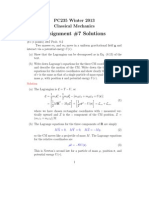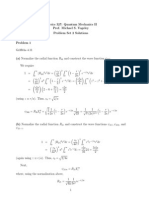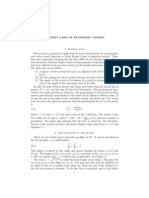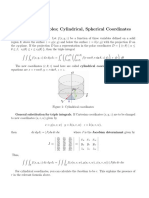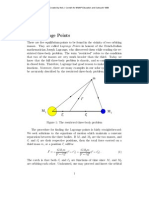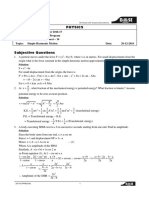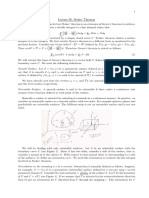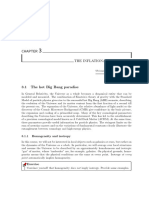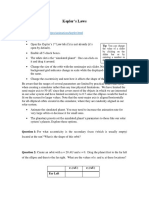16.346 Astrodynamics: Mit Opencourseware
16.346 Astrodynamics: Mit Opencourseware
Uploaded by
Awilliams083Copyright:
Available Formats
16.346 Astrodynamics: Mit Opencourseware
16.346 Astrodynamics: Mit Opencourseware
Uploaded by
Awilliams083Original Title
Copyright
Available Formats
Share this document
Did you find this document useful?
Is this content inappropriate?
Copyright:
Available Formats
16.346 Astrodynamics: Mit Opencourseware
16.346 Astrodynamics: Mit Opencourseware
Uploaded by
Awilliams083Copyright:
Available Formats
MIT OpenCourseWare http://ocw.mit.
edu
16.346 Astrodynamics
Fall 2008
For information about citing these materials or our Terms of Use, visit: http://ocw.mit.edu/terms.
Lecture 1
The Two Body Problem
1687 #3.1, #3.3
Newtons Two-Body Equations of Motion Force = Mass Acceleration Gm1 m2 (r2 r1 ) d r = m1 21 2 r r dt Gm2 m1 (r1 r2 ) d2 r2 = m2 2
r2 r dt
2
d2
(m r + m2 r2 ) = 0
dt2
1 1 G(m1 + m2 ) (r2 r1 ) d2
= 2 (r2 r1 )
r2 r dt Page 96 where rcm =
def
Conservation of Total Linear Momentum d2 rcm =0 dt2 = rcm = c1 t + c2
m1 r1 + m2 r2 m1 + m2
Two-Body Equation of Relative Motion d2 r + 3r = 0 2 dt r Vector Notation Position Vectors r1 = x1 ix + y1 iy + z1 iz r2 = x2 ix + y2 iy + z2 iz r = r2 r1 = x ix + y iy + z iz dv = 3r dt r
Page 108 r = r2 r1 r = |r| = |r2 r1 | = G(m1 + m2 )
or
where
x1 r1 = y1 z1
x2 r2 = y2 z2
x y r = r 2 r1 = z
Two-Body Equations of Motion in Rectangular Coordinates d2 x + 3x = 0 2 dt r Velocity Vectors d2 y + 3y = 0 2 dt r d2 z + 3z = 0 2 dt r
dx/dt dr dx dy dz v= = ix + iy + i = dy/dt dt dt dt dt z dz/dt
Polar Coordinates r = r ir v= ir = cos ix + sin iy i = sin ix + cos iy = dir d
dr dr di d d dr = ir + r r = ir + r i = vr ir + v i dt dt d dt dt dt
16.346 Astrodynamics
Lecture 1
Keplers Second Law
1609
Equal Areas Swept Out in Equal Times
Assume z = 0 so that the motion is conned to the x-y plane
d2 x d
dy dx
dy dx
d2 y 0 = x
2 y 2 =
x
y
=
x
y
= Constant
dt dt dt dt dt
dt dt
Using polar coordinates x = r cos y = r sin = x dx d d dy y = r2 = Constant h = 2 Area dt dt dt dt Vector Analysis for the Engineer Appendix B1 r1 r2 = x1 x2 + y1 y2 + z1 z2 = r1 r2 cos i x iy iz r1 r2 = x1 y1 z1 = r1 r2 sin in
x y z
2 2 2 x y z 1 1 1 r1 r2 r3 = x2 y2 z2
x y z
3 3 3
Josiah Willard Gibbs (18391908)
Image removed due to copyright restrictions.
(r1 r2 ) r3 = (r1 r3 )r2 (r2 r3 )r1 r1 (r2 r3 ) = (r1 r3 )r2 (r1 r2 )r3
Keplers Second Law r
1609
Conservation of Angular Momentum
d dv = (r v) = 0 = h = r v = Constant dt dt Motion takes place in a plane and angular momentum is conserved In polar coordinates dr d dr =v= ir + r i = vr i r + v i dt dt dt so that the angular momentum of m2 with respect to m1 is r = r ir m2 r v = m2 r2 Rectilinear Motion: For r d def = m2 h = Constant dt
v, then h = 0 .
16.346 Astrodynamics
Lecture 1
The quantity h is called the angular momentum but is actually the massless angular momentum. In vector form h = h i z so that h = rv and is a constant in both magnitude and direction. This is called Keplers second law even though it was really his rst major result. As Kepler expressed it, the radius vector sweeps out equal areas in equal time since 1 d h dA = Constant = r2 = dt 2 dt 2 Keplers Law is a direct consequence of radial acceleration! Eccentricity Vector d dv h h d di (v h) = h = 3 r h = 2 i r ih = 2 i = i = r dt dt r r r dt dt Hence e = v h r = Constant r
The vector quantity e is often referred to as the Laplace Vector. We will call the vector e the eccentricity vector because its magnitude e is the eccentricity of the orbit. Keplers First Law 1609 The Equation of Orbit
If we take the scalar product of the Laplace vector and the position vector, we have e r = v h r Also e r = re cos f r= r r = r v h r = h h r = h2 r r so that h2
where f is the angle between r and e or r = p ex where
def
p 1 + e cos f
p =
is the Equation of Orbit in polar coordinates. (Note that r cos f = x .) The angle f is the true anomaly and p , called the parameter, is the value of the radius r for f = 90 . The pericenter ( f = 0) and apocenter ( f = ) radii are rp = p 1+e and ra = p 1e = p = a(1 e2 )
If 2a is the length of the major axis, then rp + ra = 2a
16.346 Astrodynamics
Lecture 1
Keplers Third Law
1619
The Harmony of the World
Archimedes was the rst to discover that the area of an ellipse is ab where a and b are the semimajor and semiminor axes of the ellipse. Since the radius vector sweeps out equal areas in equal times, then the entire area will be swept out in the time interval called the period P . Therefore, from Keplers Second Law ab h = = P 2 p a(1 e2 ) = 2 2
Also, from the elementary properties of an ellipse, we have b = a 1 e2 so that the Period of the ellipse is P = 2 a3
Other expressions and terminology are used 2 = n= P a3 = n2 a3 a3 = Constant P2
Mean Motion
or
or
The last of these is known as Keplers third law. Kepler made the false assumption that is the same for all planets. Units for Numerical Calculations A convenient choice of units is Length Time Mass Then = G(m1 + m2 ) = G(msun + mplanet ) = G(msun ) = G so that, from Keplers Third Law, we have = G = 4 2 or k= G = 2 The astronomical unit (Mean distance from Earth to the Sun) The year (the Earths period) The Suns mass (Ignore other masses compared to Suns mass)
where G is the Universal Gravitation Constant.
16.346 Astrodynamics
Lecture 1
Josiah Willard Gibbs (18391908) was a professor of mathematical physics at Yale College where he inaugurated the new subject three dimensional vector analysis. He had printed for private distribution to his students a small pamphlet on the Elements of Vector Analysis in 1881 and 1884. Gibbs pamphlet became widely known and was nally incorporated in the book Vector Analysis by J. W. Gibbs and E. B. Wilson and published in 1901. Gibbs Method of Orbit Determination Pages 131133
Given r1 , r2 , r3 with r1 r2 r3 = 0 To determine the eccentricity vector e and the parameter p r r n r r n r2 = r1 + r3 with n = r1 r3 = = 2 23 and = 1 22 n n r r2 + r3 p= 1 0 = e (r2 r1 r3 ) = p r2 (p r1 ) (p r3 ) = 1+ To determine the eccentricity vector, we observe that: n e = (r1 r3 ) e = (e r1 )r3 (e
r3 )r1 = (p r1 )r3 (p r3 )r1 Then, since (n e) n = n2 e e= it follows that
1 [(p r1 )r3 n (p r3 )r1 n] n2
You might also like
- Soluciones A Problemas de Mecaninca CuanticaNo ratings yetSoluciones A Problemas de Mecaninca Cuantica7 pages
- Multiple Integrals Ii Triple Integrals: 1P1 CalculusNo ratings yetMultiple Integrals Ii Triple Integrals: 1P1 Calculus19 pages
- E. Ebrahimi and N. Riazi - (N + 1) - Dimensional Lorentzian Wormholes in An Expanding Cosmological BackgroundNo ratings yetE. Ebrahimi and N. Riazi - (N + 1) - Dimensional Lorentzian Wormholes in An Expanding Cosmological Background12 pages
- Kepler's Laws: Jesse Ratzkin September 13, 2006No ratings yetKepler's Laws: Jesse Ratzkin September 13, 20066 pages
- Thermodynamic Route To Field Equations in Gravity: Sudipta SarkarNo ratings yetThermodynamic Route To Field Equations in Gravity: Sudipta Sarkar21 pages
- Relativistic Astrophysics. 2009. Course Work 5. Solutions: X X 2 X X 2 2No ratings yetRelativistic Astrophysics. 2009. Course Work 5. Solutions: X X 2 X X 2 25 pages
- Part IB Physics B 2010-11 Answers To Classical Dynamics Examples 1No ratings yetPart IB Physics B 2010-11 Answers To Classical Dynamics Examples 112 pages
- AST1100 Lecture Notes: 1-2 Celestial MechanicsNo ratings yetAST1100 Lecture Notes: 1-2 Celestial Mechanics20 pages
- Chapter 8: Orbital Angular Momentum And: Molecular RotationsNo ratings yetChapter 8: Orbital Angular Momentum And: Molecular Rotations23 pages
- Winitzki - Heidelberg Lectures On Advanced General Relativity 2007No ratings yetWinitzki - Heidelberg Lectures On Advanced General Relativity 2007156 pages
- II IIT IRP Physics Worksheet - 14 Q + Soln - SHMNo ratings yetII IIT IRP Physics Worksheet - 14 Q + Soln - SHM17 pages
- Brachistochrone Problem and It's Real-Life Application On ArchitectureNo ratings yetBrachistochrone Problem and It's Real-Life Application On Architecture19 pages
- Diophantine Conditions and Real or Complex Brjuno Functions: 1 Hamiltonian Chaos and The Standard MapNo ratings yetDiophantine Conditions and Real or Complex Brjuno Functions: 1 Hamiltonian Chaos and The Standard Map19 pages
- Matter Waves Wave Function Quantum MechanicsNo ratings yetMatter Waves Wave Function Quantum Mechanics14 pages
- Solutions To Tutorial Lesson 1. Mechanical Engineering Principle-Tutorial. Covering Basic Questions On Distance, Velocity, Time, Pendulum, EtcNo ratings yetSolutions To Tutorial Lesson 1. Mechanical Engineering Principle-Tutorial. Covering Basic Questions On Distance, Velocity, Time, Pendulum, Etc13 pages
- On Singular Points in Story Arcs: or "I Can't Answer Your Question, But I Sure Am Glad I'm Not On That Plane!"No ratings yetOn Singular Points in Story Arcs: or "I Can't Answer Your Question, But I Sure Am Glad I'm Not On That Plane!"4 pages
- A Compendium of Spherical Astronomy, Newcomb100% (1)A Compendium of Spherical Astronomy, Newcomb470 pages
- Kepler's Law of Planetary Motion For CBSE Class 11th100% (4)Kepler's Law of Planetary Motion For CBSE Class 11th11 pages
- IX Geography Chapter 3 Rotation and RevolutionNo ratings yetIX Geography Chapter 3 Rotation and Revolution11 pages
- Astronomy and Space Science I: Dr. Hoi-Fung Chau Dr. Alex Tat-Sang ChoyNo ratings yetAstronomy and Space Science I: Dr. Hoi-Fung Chau Dr. Alex Tat-Sang Choy54 pages
- Sheniblog-Std X-Time and Season English New..No ratings yetSheniblog-Std X-Time and Season English New..58 pages
- The Hoax Called Vedic Rashichakra and Vedic Astrology!No ratings yetThe Hoax Called Vedic Rashichakra and Vedic Astrology!36 pages
- Kids Club School HALF YEARLY EXAM 2019-2020 Class 6 Subject-Social StudyNo ratings yetKids Club School HALF YEARLY EXAM 2019-2020 Class 6 Subject-Social Study2 pages
- Multiple Integrals Ii Triple Integrals: 1P1 CalculusMultiple Integrals Ii Triple Integrals: 1P1 Calculus
- E. Ebrahimi and N. Riazi - (N + 1) - Dimensional Lorentzian Wormholes in An Expanding Cosmological BackgroundE. Ebrahimi and N. Riazi - (N + 1) - Dimensional Lorentzian Wormholes in An Expanding Cosmological Background
- Thermodynamic Route To Field Equations in Gravity: Sudipta SarkarThermodynamic Route To Field Equations in Gravity: Sudipta Sarkar
- Relativistic Astrophysics. 2009. Course Work 5. Solutions: X X 2 X X 2 2Relativistic Astrophysics. 2009. Course Work 5. Solutions: X X 2 X X 2 2
- Part IB Physics B 2010-11 Answers To Classical Dynamics Examples 1Part IB Physics B 2010-11 Answers To Classical Dynamics Examples 1
- Chapter 8: Orbital Angular Momentum And: Molecular RotationsChapter 8: Orbital Angular Momentum And: Molecular Rotations
- Winitzki - Heidelberg Lectures On Advanced General Relativity 2007Winitzki - Heidelberg Lectures On Advanced General Relativity 2007
- Brachistochrone Problem and It's Real-Life Application On ArchitectureBrachistochrone Problem and It's Real-Life Application On Architecture
- Diophantine Conditions and Real or Complex Brjuno Functions: 1 Hamiltonian Chaos and The Standard MapDiophantine Conditions and Real or Complex Brjuno Functions: 1 Hamiltonian Chaos and The Standard Map
- Solutions To Tutorial Lesson 1. Mechanical Engineering Principle-Tutorial. Covering Basic Questions On Distance, Velocity, Time, Pendulum, EtcSolutions To Tutorial Lesson 1. Mechanical Engineering Principle-Tutorial. Covering Basic Questions On Distance, Velocity, Time, Pendulum, Etc
- On Singular Points in Story Arcs: or "I Can't Answer Your Question, But I Sure Am Glad I'm Not On That Plane!"On Singular Points in Story Arcs: or "I Can't Answer Your Question, But I Sure Am Glad I'm Not On That Plane!"
- Shortcuts to College Calculus Refreshment KitFrom EverandShortcuts to College Calculus Refreshment Kit
- Multiple Integrals, A Collection of Solved ProblemsFrom EverandMultiple Integrals, A Collection of Solved Problems
- Kepler's Law of Planetary Motion For CBSE Class 11thKepler's Law of Planetary Motion For CBSE Class 11th
- Astronomy and Space Science I: Dr. Hoi-Fung Chau Dr. Alex Tat-Sang ChoyAstronomy and Space Science I: Dr. Hoi-Fung Chau Dr. Alex Tat-Sang Choy
- The Hoax Called Vedic Rashichakra and Vedic Astrology!The Hoax Called Vedic Rashichakra and Vedic Astrology!
- Kids Club School HALF YEARLY EXAM 2019-2020 Class 6 Subject-Social StudyKids Club School HALF YEARLY EXAM 2019-2020 Class 6 Subject-Social Study
